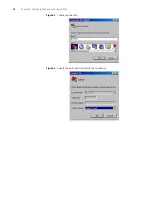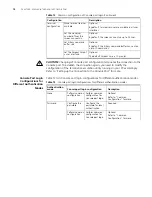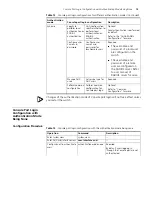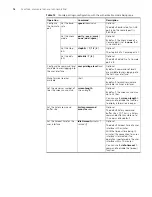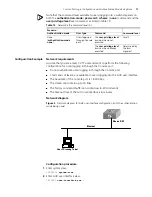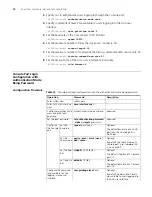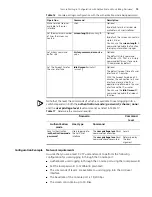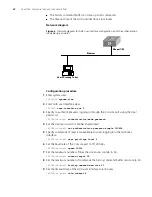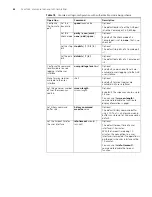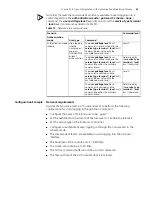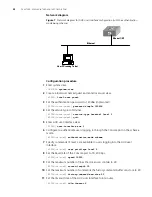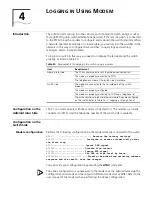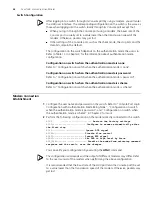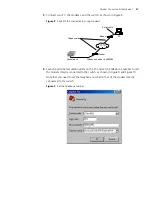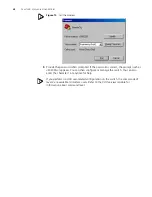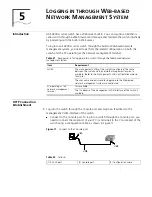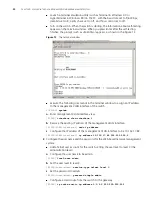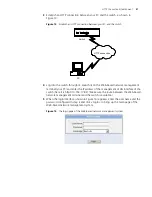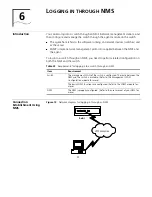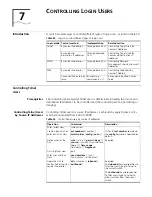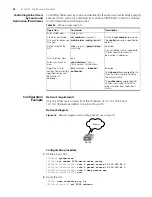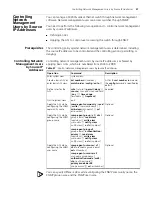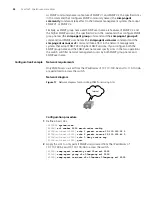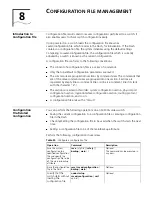
26
C
HAPTER
4: L
OGGING
IN
U
SING
M
ODEM
Switch Configuration
After logging into a switch through its Console port by using a modem, you will enter
the AUX user interface. The corresponding configuration on the switch is the same as
those when logging into the switch locally through its Console port except that:
■
When you log in through the Console port using a modem, the baud rate of the
Console port is usually set to a value lower than the transmission speed of the
modem. Otherwise, packets may get lost.
■
Other settings of the Console port, such as the check mode, the stop bits, and the
data bits, remain the default.
The configuration on the switch depends on the authentication mode the user is in.
Refer to Table 13 in Chapter 3 for the information about authentication mode
configuration.
Configuration on switch when the authentication mode is none
Refer to “Configuration on switch when the authentication mode is none”.
Configuration on switch when the authentication mode is password
Refer to “Configuration on switch when the authentication mode is password”.
Configuration on switch when the authentication mode is scheme
Refer to “Configuration on switch when the authentication mode is scheme”.
Modem Connection
Establishment
1
Configure the user name and password on the switch. Refer to “Console Port Login
Configuration with Authentication Mode Being None”, “Configuration on switch
when the authentication mode is password”, and “Configuration on switch when
the authentication mode is scheme” in Chapter 3 for more.
2
Perform the following configuration on the modem directly connected to the switch.
AT&F
-----------------------
Restore the factory settings
ATS0=1-----------------------
Configure to answer automatically after
the first ring
AT&D
-----------------------
Ignore DTR signal
AT&K0-----------------------
Disable flow control
AT&R1-----------------------
Ignore RTS signal
AT&S0-----------------------
Set DSR to high level by force
ATEQ1&W-----------------------
Disable the modem from returning command
response and the result, save the changes
You can verify your configuration by executing the
AT&V
command.
The configuration commands and the output of different modems may differ. Refer
to the user manual of the modem when performing the above configuration.
It is recommended that the baud rate of the AUX port (also the Console port) be set
to a value lower than the transmission speed of the modem. Otherwise, packets may
get lost.
Summary of Contents for 4200G 12-Port
Page 10: ...8 CONTENTS...
Page 14: ...4 ABOUT THIS GUIDE...
Page 46: ...32 CHAPTER 5 LOGGING IN THROUGH WEB BASED NETWORK MANAGEMENT SYSTEM...
Page 48: ...34 CHAPTER 6 LOGGING IN THROUGH NMS...
Page 60: ...46 CHAPTER 9 VLAN CONFIGURATION...
Page 64: ...50 CHAPTER 10 MANAGEMENT VLAN CONFIGURATION...
Page 80: ...66 CHAPTER 13 GVRP CONFIGURATION...
Page 98: ...84 CHAPTER 15 LINK AGGREGATION CONFIGURATION...
Page 112: ...98 CHAPTER 18 MAC ADDRESS TABLE MANAGEMENT...
Page 126: ...112 CHAPTER 19 LOGGING IN THROUGH TELNET...
Page 162: ...148 CHAPTER 20 MSTP CONFIGURATION...
Page 274: ...260 CHAPTER 29 IGMP SNOOPING CONFIGURATION...
Page 276: ...262 CHAPTER 30 ROUTING PORT JOIN TO MULTICAST GROUP CONFIGURATION...
Page 298: ...284 CHAPTER 33 SNMP CONFIGURATION...
Page 304: ...290 CHAPTER 34 RMON CONFIGURATION...
Page 338: ...324 CHAPTER 36 SSH TERMINAL SERVICES...
Page 356: ...342 CHAPTER 38 FTP AND TFTP CONFIGURATION...
Page 365: ...Information Center Configuration Example 351 S4200G terminal logging...
Page 366: ...352 CHAPTER 39 INFORMATION CENTER...
Page 378: ...364 CHAPTER 40 BOOTROM AND HOST SOFTWARE LOADING...
Page 384: ...370 CHAPTER 41 Basic System Configuration and Debugging...
Page 388: ...374 CHAPTER 43 NETWORK CONNECTIVITY TEST...
Page 406: ...392 CHAPTER 45 CONFIGURATION OF NEWLY ADDED CLUSTER FUNCTIONS...

